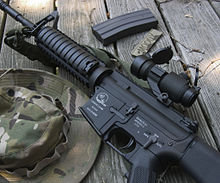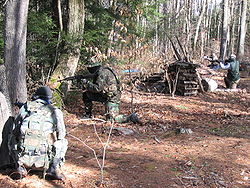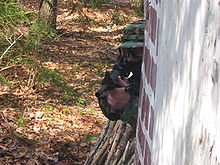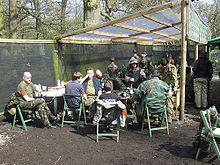- Airsoft
-
For the guns used in the activity, see Airsoft gun.
Airsoft is a recreational activity in which participants shoot round non-metallic pellets launched via replica firearms.
Gameplay varies in style and composition but often range from short-term skirmishes, organized scenarios, military simulations, historical reenactments, to competition target shooting events. Combat situations on the battlefield often involve the use of common military tactics to achieve objectives set in each game. Participants typically emulate the tactical equipment and accessories used by modern military and police organizations. Two similar alternatives to this sport are paintball and Reballing, a paintless paintball with firm foam pellets. Softair is also the subject of Cosimo Alema's 2010 thriller film War Games: At the End of the Day.[citation needed]
Contents
History
Airsoft was created and marketed in Japan in the late 1970s, due to civilian ownership of firearms being banned. Airsoft was used to closely emulate real guns. Now airsoft guns have been adapted with a purely recreational application in mind, and the sport is enjoyed by all ages. Many airsoft guns are produced in China and Japan. Airsoft guns are also produced in the United States and Taiwan[1].
Ballistics and velocity
For more details on Airsoft pellet ballistics, see Airsoft pellets#Pellet ballistics.Kinetic energy is the energy that is in the pellet while it moves, and it is transferred to its target upon impact. One joule of energy will be transferred by a 0.20 g BB traveling at 100 metres per second (330 ft/s).[2] A typical set of limits on guns might be 100 m/s (330 ft/s) for CQB (Close Quarters Battle), 350 ft/s for outdoors, and 175 m/s (570 ft/s) for bolt action sniper rifles, all measured with a 0.20 g BB. The speed of the BB depends on the weight of the BB and amount of kinetic energy the gun can transfer to the BB. Certain places play "no velocity limit" games. In California a common limit for CQB is 350 ft/s (110 m/s). On most fields in America the limit for AEG (Automatic Electric Gun) guns is usually in the 400 ft/s (120 m/s) range. For snipers the range can be anywhere from 400 to 600 ft/s (180 m/s). Guns have these high velocities to go farther and have greater accuracy, but fire rate is compromised unless a smaller spring is added (preferably 110%). Furthermore, the lower velocity means that the BB will glide more, which is a good thing for indoor skirmishes, but outside the wind usually catches hold of it and spirals it out of its course.[citation needed]
In the United Kingdom, Ireland, and Italy, the energy limit for Airsoft guns is one joule (100 m/s with a 0.20 g, 6 mm BB) regardless of the type of game play.[3] Some UK sites allow semi-automatic-only weapons up to 400 ft/s (120 m/s) and bolt action rifles up to 500 ft/s (150 m/s). Northern Ireland has a maximum velocity of 328 ft/s (100 m/s) with 0.2 gram BB without regard to the type of weapon. 1J is the about same energy as a tennis ball being dropped from a meter and a half.
Most Airsoft guns are capable of shooting from 50 m/s (160 ft/s) to 125 m/s (410 ft/s), although it is also possible to purchase upgraded internals for some Airsoft guns that will enable up to 210 m/s (690 ft/s) projectile velocities.[4]
Safety
Eye and face protection
The minimum safe level of gear required to participate in most games includes a pair of impact-rated goggles to protect participants' eyes. If shot from at least ten feet away by a gun with typical muzzle velocity, there will be minimal damage to other body parts. Traditional prescription glasses and sunglasses, or goggles not designed specifically for use with airsoft or paintball guns, may break or shatter upon being struck causing damage to the eye. The largest review of airsoft eye injuries found no case of loss of vision from an airsoft eye injury.[5] The same review found that only one of the 59 cases was wearing anything over their eye, and that was one patient who was wearing just sunglasses as eye protection.
Full-face masks (similar to, and often including paintball masks) cover the rest of the face, protecting vulnerable parts such as teeth. Some airsoft masks are made with mesh screens, although there is debate that fragments from lower quality or bio-degradable BBs may pass through the mesh and enter the eye. However, there have been no recorded incidents of such an occurrence.[6] Masks with mesh screens are often preferred by players who wear prescription eyeglasses as they increase ventilation and reduce the amount of condensation on the lenses, while the lenses provide additional protection against possible fragments that might penetrate the mesh.
While masks offer superior protection, they can interfere with the use of scopes, and in cheaper masks, condensation inside the goggles can reduce visibility. During very hot days the masks can also cause the player to overheat more quickly due to the lack of air circulation. Some players have mounted small battery-powered fans (designed for computer circuit boards) on the masks to improve ventilation and reduce or avoid condensation.[citation needed]
Community safety precautions
Rules such as a maximum muzzle velocity and engagement distance guidelines are used by different groups. Some organizations have created common safety rules and guidelines.[7]
When not actively playing, some fields require "barrel bags", also known as barrel stoppers, to be placed over the muzzle of the gun. The magazine is usually removed as well, and the gun fired to clear the chamber. Most fields also require players to leave their guns set to the safety position when they are not shooting, a practice common when using real firearms. In certain countries, such as the Philippines, additional special rules have been adopted.[8]
Legal restrictions
Main article: Legal issues in airsoft Classic Army M15A4 Automatic Electric Gun.
Classic Army M15A4 Automatic Electric Gun.
Owning airsoft guns and playing airsoft is legal in most parts of the world. Some countries have specific restrictions,[9] such as maximum muzzle velocity and "unrealistic" colouring to distinguish them from actual firearms. They are legal throughout the U.S, but restrictions do exist in certain cities such as Camden NJ; Chicago, IL; and Detroit, MI. The states of New Mexico and Michigan, however, do not allow airsoft guns to be used or handled publicly because of the resemblance to real firearms. They may be used on private property with the consent of the owner. The Customs and Border Protection FAQ page states that Airsoft guns are considered look-alike firearms which require the special blaze orange marking.[10]
In the United Kingdom, airsoft replicas are classified as realistic imitation firearms or RIFs. The sale, manufacture, or importation of RIFs are restricted to activities that are exempted or have been granted a defense by the Home Office under the Violent Criminal Reduction Act (VCRA). Airsoft skirmishing has been granted a specific defense against the requirements of the act, and a skirmisher as defined under British law is allowed to be sold (note: purchase is not illegal - sale is - the crime is committed by the vendor), manufacture (& modify an IF into a RIF), and import airsoft replicas. All are still however crimes under British law that can be defended successfully (in theory - this has never been tried to date) by fulfilling criteria suggested in the guidelines accompanying the VCRA. The most accepted method of proving entitlement to the defense is to be a member of a site that holds public liability insurance. An association set up by UK retailers, called the United Kingdom Airsoft Retailers Association (UKARA), in line with the Home Office documentation accompanying the VCRA, recommends that an airsoft site only give membership to a player who has played at least three games over a period of no less than two months. It is also possible for a member of an insured reenactment society or the film or television industry to purchase an Airsoft replica (this is a full exemption from, and not a defence against, the VCRA).[11] The right to buy a RIF (or IF) is still reserved for individuals age 18 and over.[12]
Many retailers are part of the UKARA scheme and will only sell to players who are registered to a skirmish site that fulfills the desired requirements for the VCRA Defense. Retailers must renew their membership annually. The Association has a database of registered players from approved airsoft sites that is updated on a regular basis by the sites themselves. Retailers who are members of UKARA have access to the database and can check for proof of eligibility for purchasing access to the player's site membership number before selling any RIFs to private individuals.
Other schemes have been attempted to allow Airsoft players to comply with the Violent Crime Reduction Act 2006, but none have been successfully implemented. The use or possession of any kind of replica weapon—loaded or otherwise—in a public place without valid reason is an offense under UK law and can carry heavy penalties.[13]
As an alternative to RIFs, IFs (Imitation Firearms, including 'two tones') are available. These are RIFs which have been painted a bright colour (excluding white/silver/gold) over 51% of the item. No specific defense is required for purchase of IFs; however, they are strongly discouraged and sometimes banned from skirmishes because some players feel that they undermine the requirement for a specific skirmisher's defense.[citation needed] IFs exist primarily to enable non-skirmish retailers to sell imitations to the general public.
Orange-tipped airsoft gun muzzles
Federal law in the United States requires that a 6 mm (0.24 in) orange tip to be present on all "toy guns" (including airsoft replicas) while being imported into the United States. These brightly coloured tips show the difference between real and replica firearms, which helps to ensure safety.[14] However, when playing on a field, no orange tip is needed. The federal regulations do not require the owner to keep the muzzle painted after acquiring their airsoft gun. Few players choose to keep the tip, whether for safety or varies other reasons, and some switch their orange-painted flash hiders with more realistic ones shortly before playing while at the field's staging area.
Airsoft guns
Main article: Airsoft gunThe guns used in airsoft are typically imitation firearms. They have a mechanism for pushing out projectiles 6 mm or 8 mm in diameter.
Airsoft guns are classified according to their operating principle, which can be spring, electric which is AEG or batteries, or gas-powered. Some companies produce full replicas of counterpart grenade launchers which fire a projectile spray of 6mm pellets by use of a high-powered spring mechanism or a form of compressed gas propellant (i.e. green gas, propane, or CO2).
An airsoft gun made by Celcius Technology (Hong Kong). This Training Weapon model is a replica of the M4A1 and has also installed a G&P Trijicon ACOG scope replica.
Newer guns, especially those made in Taiwan and China, have metal internal and external parts. Japan has specific rules about producing airsoft with metal parts. A typical airsoft gun is noticeably lighter than its "real steel" counterpart due to the use of aluminum, alloy, and plastic, though some have weights in them for a more realistic feel. Smoke caps are available for certain airsoft guns to add realism.
Gas hand gun magazines usually contain 10 to 20 BBs in a standard capacity magazine; however, some are high capacity magazines which have a winder and can hold 50 rounds or more. In the case of AEG rifles, magazines come in either real-capacity (equivalent to the capacity of its real steel counterpart), low-capacity (low caps: 30-80 BBs), mid-capacity (mid caps: 80-150 BBs), or high-capacity (high caps: 200+ BBs). These magazines are spring-loaded. The high-cap magazines often have a ratchet wheel that can be wound up periodically to force BBs up from the holding chamber of the magazine to the feed camber. Due to loose BBs in the reservoir, they often make a rattling noise when running or walking. Some airsoft guns have an electric-powered box or drum magazine that holds thousands of BBs.
Hop-Up
The "Hop-Up" system, which is installed in most stock airsoft rifles and pistols, is used to add extra range to the pellets by putting a backspin on each as it is fired. Hop-Up is short for "High Operation Power Up". A small rubber nub protrudes into the top of the barrel through a small hole, and it catches the top of the BB as it flies past. Adjusting the Hop-Up makes the nub protrude lower or higher into the barrel, so that backspin is increased or reduced. Ideally, the Hop-Up should be adjusted so that the pellets fly as far as possible in a straight line. Hop-Up does decrease the velocity of the projectile (a gun firing 340 ft/s (100 m/s) with the hop fully unwound can drop as low as 300 ft/s (91 m/s) with the Hop-Up set in accordance to maximized straight shooting and maximum range even in a well set up weapon).[citation needed] The Hop-Up adjustment is usually relatively easy to access so that players can adjust it during play. On the majority of airsoft guns, it is located underneath the in-built bolt cover, but sometimes it is only accessible by using an Allen key, or occasionally inside the gun itself, requiring disassembly for adjustment. Few lower priced gun models have an adjustable hop up system.[citation needed]
Airsoft projectiles
Main article: Airsoft pelletsMost airsoft guns fire round plastic pellets ranging from 0.12 plastic to 0.88 grams. However, the most popular weights for AEG's (automatic electric gun) are between 0.20 and 0.25 grams. Heavier rounds (0.30–0.48 grams) are typically used for long range and sniper use since they are more stable in flight and less easily deflected by wind. They are usually bought in bags or bottles of 2,000 to 5,000, but other sizes are available, such as a 250,000 round of tournament grade pellets. Pellets are typically 6 mm in diameter, though 8 mm pellets do exist. These pellets are available in the 0.12 to 0.60 gram range. The pellet weight depends on the gun. For instance,a high end automatic rifle uses between 0.20–0.30 gram BBs, while snipers work best with 0.40 or higher. Most experienced airsoft players prefer not to use 0.12 gram BBs in their high end guns, which tend to jam and break inside the barrel and Hop-Up. However, 0.12 g BBs do work well with the less expensive plastic pistols or spring guns. Pellets are used for the majority of play, although foam balls may be used to represent M203 styled rifle-grenade shells.[citation needed]
See also
References
- ^ Collaborative list of Airsoft brands, manufacturers and retailers
- ^ Airsof2day.com » The basic physics of airsoft from Airsoft2day.com
- ^ "Firearms Controls Consultation - UKASGB Response". United Kingdom Airsoft Sites Governing Body. http://www.ukasgb.org.uk/fcc_response.pdf. Retrieved 4 November 2010.
- ^ "Feet Per Second". AirSOCOM. http://www.airsocom.com/Airsoft/Feet_Per_Second.html. Retrieved 4 November 2010.
- ^ Kratz A - Am J Ophthalmol - 01-JAN-2010; 149(1): 37-44
- ^ "Durability Test - Mesh Masks.". Amplified Airsoft. http://www.ampair.net/e107_plugins/content/content.php?content.102. Retrieved 4 November 2010.
- ^ 09:45 AM. "Texas Airsoft Organization". Texasairsoft.org. http://www.texasairsoft.org. Retrieved 2011-09-13.
- ^ Filipino Airsoft Players (FAP) Standard Rules and Regulations: http://www.filairsoft.com/forum/showthread.php?t=821
- ^ Complete list of Airsoft legal requirements in the world
- ^ "CBP FAQ". https://help.cbp.gov/app/answers/detail/a_id/809. Retrieved 1 August 2010.
- ^ "Specific defences applying to the offence under s. 36". http://www.statutelaw.gov.uk/content.aspx?LegType=All+Legislation&searchEnacted=0&extentMatchOnly=0&confersPower=0&blanketAmendment=0&sortAlpha=0&PageNumber=0&NavFrom=0&parentActiveTextDocId=0&activetextdocid=2922622&versionNumber=1. Retrieved 20 January 2011.
- ^ "UKARA Q&A". http://www.ukara.org.uk/node/18. Retrieved 13 March 2008.
- ^ BASC - Airguns and Replicas
- ^ "Electronic Code Of Federal Regulations, Title 15: Commerce and Foreign Trade, PART 1150—MARKING OF TOY, LOOK-ALIKE AND IMITATION FIREARMS". Government Accountability Office via http://ecfr.gpoaccess.gov.+30 January 2008. http://ecfr.gpoaccess.gov/cgi/t/text/text-idx?c=ecfr&sid=fe6593e6c18f07b9f6b29ffca8409aa9&rgn=div5&view=text&node=15:3.1.3.7.1&idno=15. Retrieved 1 February 2008.
External links
Categories:- Leisure activities
- Airsoft
Wikimedia Foundation. 2010.







